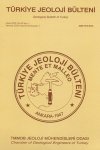
-
2025
-
2024
-
2023
-
2022
-
2021
-
2020
-
2019
-
2018
-
2017
-
2016
-
2015
-
2014
-
2013
-
2012
-
2011
-
2010
-
2009
-
2008
-
2007
- 2006
-
2005
-
2004
-
2003
-
2002
-
2001
-
2000
-
1999
-
1998
-
1997
-
1996
-
1995
-
1994
-
1993
-
1992
-
1991
-
1990
-
1989
-
1988
-
1987
-
1986
-
1985
-
1984
-
1983
-
1982
-
1981
-
1980
-
1979
-
1978
-
1977
-
1976
-
1975
-
1974
-
1973
-
1972
-
1971
-
1970
-
1969
-
1968
-
1966
-
1964
-
1963
-
1961
-
1959
-
1958
-
1955
-
1954
-
1953
-
1952
-
1951
-
1950
-
1949
-
1948
-
1947
Abstract: Çamoluk (Burdur) iron-manganese mineralizations are found in the Middle Triassic-Liassic(Jurassic)Dutdere limestone. The mineralizations are situated in Akpınarkale Tepe, Kulübe Tepe andElmaçukuru locations. The iron-manganese mineralizations have thicknesses ranging from 0.6 m to 2 m andare seen generally cutting limestones in lenticular and normal vein forms. Mineral assemblage consists ofpyrolusite, psilomelane, cryiptomelane, hausmannite, hollandite, coronadite, chalcophanite, todorokite,braunite, manganite, pyrite, limonite (goethite), hematite, barite, quartz, cristobalite, calcite, chlorite,mica/illite, jarosite, and feldspar.In the iron-manganese occurrences, average composition is 30.51 % Fe O ,23.60 % MnO and 10.07 2 3% SiO . It was determined that the iron- manganese occurrences in the study area have high amounts of Ba, Sr, 2As, Zn, Pb, and Sb contents. Ba and Sr contents range between 0.4 % and 36.1 %, averaging 4.9 %, between0.01 % and 0.9 %, averaging 0.1%, respectively. Findings such as epigenetic vein form, mineral assemblage, higher trace element contents, and BaSr are significant evidences of a hydrothermal-metasomatic origin.
Abstract: The qualitative investigation of 54 grab samples and 14 gravity cores from the Saros Gulf was carriedout in order to understand the present and recent prevailing sedimantological conditions. Observations ongrab samples show that the western part of the northern shelf is covered by a sandy siliciclastic lobe.Gastropods prefer shallower (<-50 m) depths, while large bivalve shells are common within mud even at -150m water depth. Sedimentological evaluation of the gravity cores provided the occurrence of a type-1unconformity and overlying 50-130 cm thick fining/deepening upward cycle in the northern shelf as deep as -85 m water depth. Below this unconformity of at least 20 km extend, semi-consolidated salt-bearing mudoccurs while intraformational blocks and coquinites are found above. Based on the environmentalinterpretations and relating the obtained results to the previous works, this unconformity and followingsediments were assumed to be the record of Holocene transgression in the Saros Gulf.
View as PDF
Abstract: This study was performed on the recent foraminiferal samples of totally 49 collected fromGökçeada surroundings, southwestern Bozcaada, eastern Mitilini in the northeast of Aegean Sea in and in different points of shores in the southwest of Antalya. Total 24 genus and 41 species offoraminifers with colored shells were distinguished in the four regions. d(104) reflection and MgCO3contents) of calcites vary between 2.979-3.035 Å and 0.33-19.00 % mole, respectively. Mg/Ca andSr/Ca ratios of whole shells have values of 2.95-51.51 and 1.45-10.44. The values are normalized byconsidering maximum and minimum concentrations are respectively due to colorful and colorlessforaminifer shells in the chemical analyses from whole shells and their surfaces. The enrichments inamounts of particularly metallic elements concern with absorption depending on qualitative andquantitative of shell structures although the variations are also related to mineralogicalcompositions of shells. It can be considered that the ions transferred in hot waters coming fromactive faults in the sea-floor and/or the ions transported with cold waters releasing from land areenriched in the sea, and finally they caused an abnormal contamination within the shells and/orsecondarily richness during metabolism by livings.

 TMMOB
TMMOB